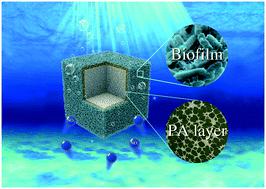当前位置:
X-MOL 学术
›
Environ. Sci.: Water Res. Technol.
›
论文详情
Our official English website, www.x-mol.net, welcomes your
feedback! (Note: you will need to create a separate account there.)
Effective control of the carbon release of starch/polyvinyl alcohol based on a polyamide coating in solid-phase denitrification
Environmental Science: Water Research & Technology ( IF 3.5 ) Pub Date : 2020-10-05 , DOI: 10.1039/d0ew00721h Wande Ding 1, 2, 3, 4, 5 , Huan Liu 1, 2, 3, 4 , Kefeng Zhang 1, 2, 3, 4 , Dongxiao Lv 1, 2, 3, 4 , Shan Wang 1, 2, 3, 4
Environmental Science: Water Research & Technology ( IF 3.5 ) Pub Date : 2020-10-05 , DOI: 10.1039/d0ew00721h Wande Ding 1, 2, 3, 4, 5 , Huan Liu 1, 2, 3, 4 , Kefeng Zhang 1, 2, 3, 4 , Dongxiao Lv 1, 2, 3, 4 , Shan Wang 1, 2, 3, 4
Affiliation

|
Inspired by the controlled release technique of microcapsules, a novel carbon source using starch/polyvinyl alcohol (PVA) as the active material and a polyamide layer (PAL) as the shell coating on the surface of the carbon source was prepared and used for denitrification. Compared to the pure starch/PVA, the PAL-coated carbon source showed a lower chemical oxygen demand (COD) concentration (20 mg L−1) in effluent with excellent removal rate of NO3−-N exceeding 95% when the mass ratio of starch to PVA was 3 : 1. The high content of starch in the composite carbon source contributed to a decrease of denitrification cost. The carbon balance result indicated that the carbon release of the PAL-coated carbon source was mainly caused by microbial action (72.9%). Besides, little difference of microbial community was observed between pure starch/PVA and PAL-starch/PVA supported systems and the vast majority of biofilm species belonged to the six major phyla Proteobacteria, Bacteroidetes, Firmicutes, Planctomycetes, Chloroflexi and Actinobacteria, and Thauera and Zoogloea were the major genera which were denitrifying bacteria. In all, these results demonstrated that the PAL played a vital role in controlling COD in effluent without degrading the denitrification efficiency, as well as changing the structure of the microbial community, which paves a new way to fabricate a novel solid carbon source with low cost and excellent denitrification performance.
中文翻译:

固相反硝化中基于聚酰胺涂层的淀粉/聚乙烯醇碳释放的有效控制
受微胶囊控释技术的启发,以淀粉/聚乙烯醇(PVA)为活性材料,聚酰胺层(PAL)为壳包衣材料在碳源表面制备了新型碳源,并用于反硝化。相比于纯淀粉/ PVA,所述PAL-涂覆的碳源显示出较低的化学需氧量(COD)浓度(20毫克的L -1在流出物)与NO的优良去除率3 -当淀粉与PVA的质量比为3∶1时,-N超过95%。复合碳源中淀粉的高含量有助于降低反硝化成本。碳平衡结果表明,PAL涂层碳源的碳释放主要由微生物作用引起(72.9%)。此外,观察纯淀粉/ PVA和PAL-淀粉之间的微生物群落的差别不大/ PVA支持系统和广大生物膜物种属于六大门类变形菌,拟杆菌,厚壁菌门,浮霉菌门,绿弯菌门和放线菌和Thauera和动物群是反硝化细菌的主要属。总之,这些结果表明,PAL在控制废水中的COD而不降低反硝化效率以及改变微生物群落结构方面发挥着至关重要的作用,这为低成本制造新型固体碳源开辟了一条新途径。以及出色的反硝化性能。
更新日期:2020-11-03
中文翻译:

固相反硝化中基于聚酰胺涂层的淀粉/聚乙烯醇碳释放的有效控制
受微胶囊控释技术的启发,以淀粉/聚乙烯醇(PVA)为活性材料,聚酰胺层(PAL)为壳包衣材料在碳源表面制备了新型碳源,并用于反硝化。相比于纯淀粉/ PVA,所述PAL-涂覆的碳源显示出较低的化学需氧量(COD)浓度(20毫克的L -1在流出物)与NO的优良去除率3 -当淀粉与PVA的质量比为3∶1时,-N超过95%。复合碳源中淀粉的高含量有助于降低反硝化成本。碳平衡结果表明,PAL涂层碳源的碳释放主要由微生物作用引起(72.9%)。此外,观察纯淀粉/ PVA和PAL-淀粉之间的微生物群落的差别不大/ PVA支持系统和广大生物膜物种属于六大门类变形菌,拟杆菌,厚壁菌门,浮霉菌门,绿弯菌门和放线菌和Thauera和动物群是反硝化细菌的主要属。总之,这些结果表明,PAL在控制废水中的COD而不降低反硝化效率以及改变微生物群落结构方面发挥着至关重要的作用,这为低成本制造新型固体碳源开辟了一条新途径。以及出色的反硝化性能。











































 京公网安备 11010802027423号
京公网安备 11010802027423号